Cantore Arithmetic will now: The Pillars of Creation are wet comma and the Sutter Buttes are the rapture to the Pillars of Creation as only a rhapsody(as in Mozart!)
You searched for
"WET" in the KJV Bible
6 Instances - Page 1 of 1 - Sort by Book Order - Feedback
- Job 24:8chapter context similar meaning copy save
- They are wet with the showers of the mountains, and embrace the rock for want of a shelter.
- Daniel 4:33chapter context similar meaning copy save
- The same hour was the thing fulfilled upon Nebuchadnezzar: and he was driven from men, and did eat grass as oxen, and his body was wet with the dew of heaven, till his hairs were grown like eagles' feathers, and his nails like birds' claws.
- Daniel 4:15chapter context similar meaning copy save
- Nevertheless leave the stump of his roots in the earth, even with a band of iron and brass, in the tender grass of the field; and let it be wet with the dew of heaven, and let his portion be with the beasts in the grass of the earth:
- Daniel 4:23chapter context similar meaning copy save
- And whereas the king saw a watcher and an holy one coming down from heaven, and saying, Hew the tree down, and destroy it; yet leave the stump of the roots thereof in the earth, even with a band of iron and brass, in the tender grass of the field; and let it be wet with the dew of heaven, and let his portion be with the beasts of the field, till seven times pass over him;
- Daniel 5:21chapter context similar meaning copy save
- And he was driven from the sons of men; and his heart was made like the beasts, and his dwelling was with the wild asses: they fed him with grass like oxen, and his body was wet with the dew of heaven; till he knew that the most high God ruled in the kingdom of men, and that he appointeth over it whomsoever he will.
- Daniel 4:25chapter context similar meaning copy save
- That they shall drive thee from men, and thy dwelling shall be with the beasts of the field, and they shall make thee to eat grass as oxen, and they shall wet thee with the dew of heaven, and seven times shall pass over thee, till thou know that the most High ruleth in the kingdom of men, and giveth it to whomsoever he will.
Pillars of Creation
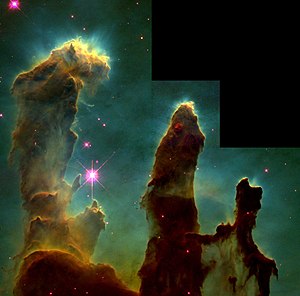
(animation; 0:15; 11 November 2022)
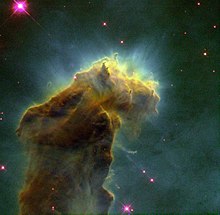
Pillars of Creation is a photograph taken by the Hubble Space Telescope of elephant trunks of interstellar gas and dust in the Eagle Nebula, in the Serpens constellation, some 6,500–7,000 light-years (2,000–2,100 pc; 61–66 Em) from Earth.[1] These elephant trunks had been discovered by John Charles Duncan in 1920 on a plate made with the Mount Wilson Observatory 60-inch telescope.[2][3]They are named so because the gas and dust are in the process of creating new stars, while also being eroded by the light from nearby stars that have recently formed.[4]
Taken on April 1, 1995, it was named one of the top ten photographs from Hubble by Space.com.[5]The astronomers responsible for the photo were Jeff Hester and Paul Scowen from Arizona State University. The region was rephotographed by ESA's Herschel Space Observatory in 2011, again by Hubble in 2014 with a newer camera, and the James Webb Space Telescope in 2022.
Released in 2007, Chandra X-ray Observatory (AXAF) had observed the area in 2001. It did not find many X-ray sources in the towers but was able to observe sources at various X-ray energy levels in the area from young stars.[6]
The image is noted for its global culture impact, with National Geographic noting on its 20th anniversary that the image had been featured on everything from "t-shirts to coffee-mugs".[7]
Name[edit]
The name is based on a phrase used by Charles Spurgeon in his 1857 sermon "The Condescension of Christ":[8]
Composition[edit]
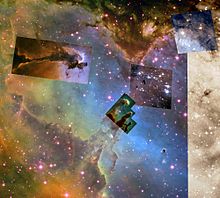
The pillars are composed of cool molecular hydrogen and dust that are being eroded by photoevaporation from the ultraviolet light of relatively close and hot stars. The leftmost pillar is about four light years in length.[9] The finger-like protrusions at the top of the clouds are larger than the Solar System, and are made visible by the shadows of evaporating gaseous globules (EGGs), which shield the gas behind them from intense UV flux.[10] EGGs are themselves incubators of new stars.[11] The stars then emerge from the EGGs, which then are evaporated.
Theorized destruction[edit]
Images taken with the Spitzer Space Telescope uncovered a cloud of dust in the vicinity of the Pillars of Creation that hypothetically could be a shock wave produced by a supernova.[12] The appearance of the cloud suggests the supernova shockwave would have destroyed the Pillars of Creation 6,000 years ago. Given the distance of roughly 7,000 light-years between Earth and the Pillars of Creation, this would mean that they have actually already been destroyed, but because light travels at a finite speed, this destruction should be visible from Earth in about 1,000 years.[13]
This interpretation of the hot dust has been disputed by an astronomer uninvolved in the Spitzer observations, who argues that a supernova should have resulted in stronger radio and x-ray radiation than has been observed, and that winds from massive stars could instead have heated the dust. If this is the case, the Pillars of Creation will undergo a more gradual erosion.[14]
Photographs[edit]
Original Hubble Space Telescope photo[edit]
Hubble's photo of the pillars is composed of 32 different images[15] from four CCD images[16] in the Wide Field and Planetary Camera 2 on board Hubble.[17] The photograph was made with light emitted by different elements in the cloud and appears as a different color in the composite image: green for hydrogen, red for singly ionized sulfur and blue for double-ionized oxygen atoms.[4]
The "stair-shaped"[16] missing part of the picture at the top right corner originates from the fact that the camera for the top-right quadrant has a magnified view; when its images are scaled down to match the other three cameras, there is necessarily a gap in the rest of that quadrant.[16] This effect is also present on other WFPC2 images, and can be displayed at any corner depending on how the image has been re-oriented for publication.[18]
The Wide Field and Planetary Camera 2 was replaced by the Wide Field Camera 3, and the former was taken back to Earth where it is displayed in a museum. It was replaced in 2009 as part of a Space Shuttle mission (STS-125).
Herschel's photo[edit]
In 2010 Herschel Space Observatory captured a new image of the Pillars of Creation in far-infrared wavelengths, which allows astronomers to look inside the pillars and structures in the region, and come to a much fuller understanding of the creative and destructive forces inside the Eagle Nebula.[19]
Revisits[edit]
In celebration of the 25th anniversary since the launch of the Hubble Space Telescope, astronomers assembled a larger and higher-resolution photograph of the Pillars of Creation which was unveiled in January 2015 at the American Astronomical Society meeting in Seattle. The image was photographed by the Hubble Telescope's Wide Field Camera 3, installed in 2009, in visible light. An infrared image was also taken.[20] The re-imaging has a wider view that shows more of the base of the nebulous columns.[7]
In October 2022, it was unveiled that the James Webb Space Telescope captured a new image of the Pillars of Creation utilizing the NIRCam aboard the spacecraft. The image was able to capture ejections from the formation of young stars still in development in great detail, as seen by the red spots near the edges of the pillars.[21][22]



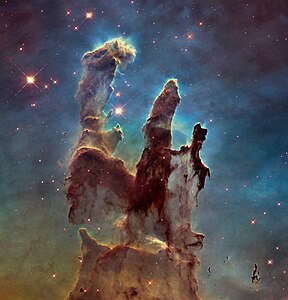
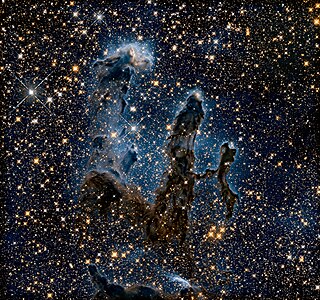










No comments:
Post a Comment